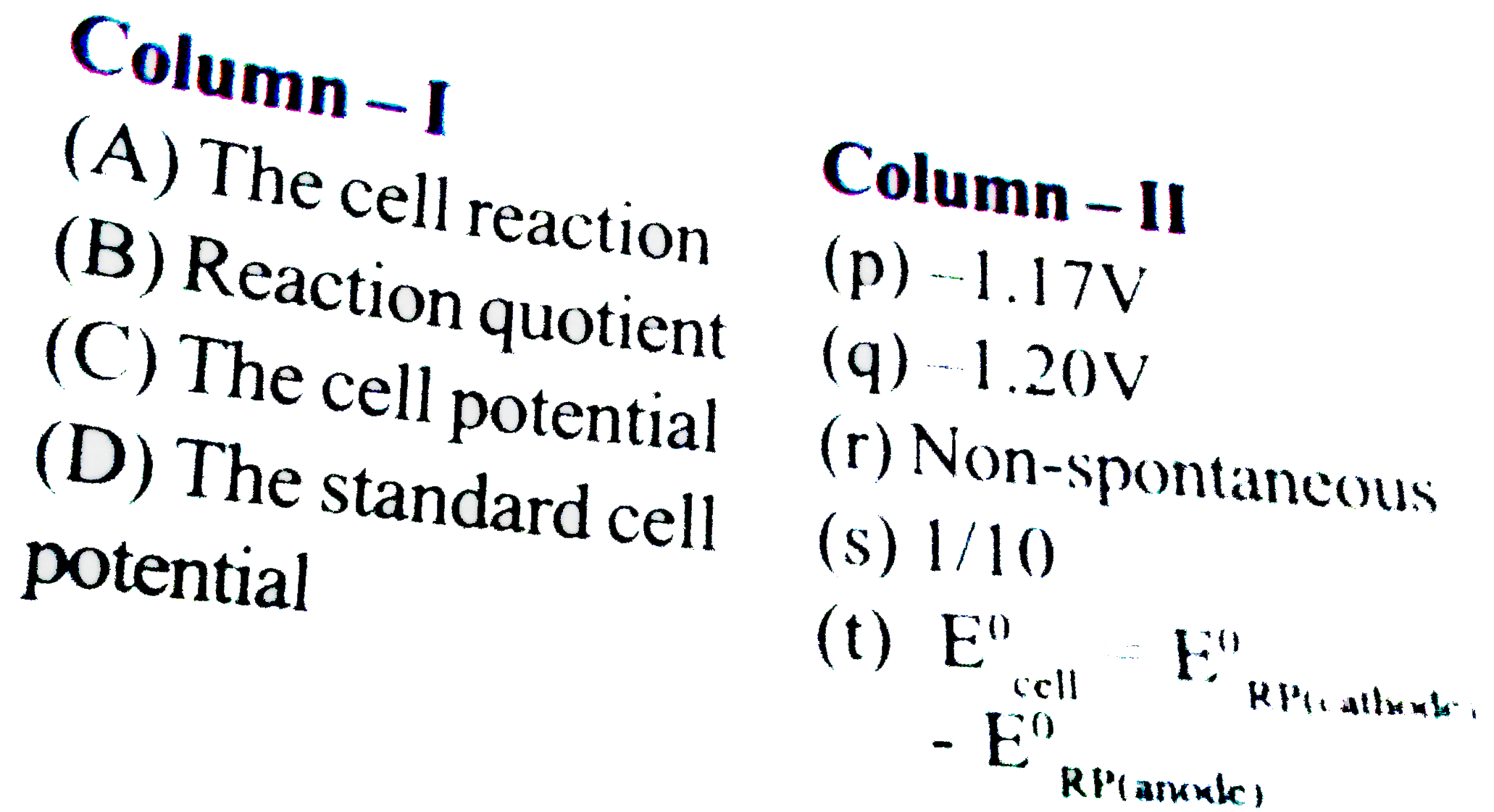Calculate the cell potential for the cell,
The correct Answer is:
To calculate the cell potential for the given electrochemical cell, we will follow these steps:
Step 1: Identify the half-reactions and their standard reduction potentials.
- The cell is composed of two half-cells:
- Nickel half-cell: Ni2++2e−→Ni(s) with E∘Ni2+/Ni=−0.25V
- Silver half-cell: Ag++e−→Ag(s) with E∘Ag+/Ag=+0.80V
Step 2: Determine which half-reaction is the anode and which is the cathode.
- The half-reaction with the higher standard reduction potential will occur at the cathode, while the one with the lower standard reduction potential will occur at the anode.
- In this case:
- Cathode: Silver half-cell (higher potential, +0.80V)
- Anode: Nickel half-cell (lower potential, −0.25V)
Step 3: Use the formula for cell potential.
- The standard cell potential E∘cell is calculated using the formula:
E∘cell=E∘cathode−E∘anode
Step 4: Substitute the values into the formula.
- Substitute the values of the standard reduction potentials into the formula:
E∘cell=E∘Ag+/Ag−E∘Ni2+/Ni
E∘cell=0.80V−(−0.25V)
Step 5: Perform the calculation.
- Simplifying the equation:
E∘cell=0.80V+0.25V=1.05V
Final Answer:
- The cell potential for the given electrochemical cell is E∘cell=1.05V.
---
- The cell is composed of two half-cells:
- Nickel half-cell: Ni2++2e−→Ni(s) with E∘Ni2+/Ni=−0.25V
- Silver half-cell: Ag++e−→Ag(s) with E∘Ag+/Ag=+0.80V
- The half-reaction with the higher standard reduction potential will occur at the cathode, while the one with the lower standard reduction potential will occur at the anode.
- In this case:
- Cathode: Silver half-cell (higher potential, +0.80V)
- Anode: Nickel half-cell (lower potential, −0.25V)
- The standard cell potential E∘cell is calculated using the formula:
E∘cell=E∘cathode−E∘anode
- Substitute the values of the standard reduction potentials into the formula:
E∘cell=E∘Ag+/Ag−E∘Ni2+/Ni
E∘cell=0.80V−(−0.25V)
- Simplifying the equation:
E∘cell=0.80V+0.25V=1.05V
- The cell potential for the given electrochemical cell is E∘cell=1.05V.
Topper's Solved these Questions
- ELECTROCHEMISTRYBOOK - DINESH PUBLICATIONCHAPTER - ELECTROCHEMISTRYEXERCISE - ADDITIONAL NUMERICAL PROBLEMS FOR PRACTICE
12 Videos
- ELECTROCHEMISTRYBOOK - DINESH PUBLICATIONCHAPTER - ELECTROCHEMISTRYEXERCISE - HOTS
17 Videos
- D-AND -F BLOCK ELEMENTSBOOK - DINESH PUBLICATIONCHAPTER - D-AND -F BLOCK ELEMENTSEXERCISE - BRAIN STORMING MULTIPLE CHOICE QUESTIONS (MCQS)
13 Videos
- ETHERSBOOK - DINESH PUBLICATIONCHAPTER - ETHERSEXERCISE - (MCQs)
8 Videos
Similar Questions
Knowledge Check
The potential of the cell
V(s)∣∣V3+(aq.,0.0011M)∣∣∣∣Ni2+(aq.,0.24M)∣∣∣Ni(s) isA0.50VB0.40VC0.70VD0.80VGiven E∘Ag+/Ag=+0.8V , E∘Ni+2/Ni=−0.25V. Which of the folowing statements is true?
AAg+ is an oxidizing agent but Ni+2 is a reducing agent.BNi+2 can be reduced by silver metalCAg+ is a better oxidizing agent than Ni2+ and Ni is a better reducing agent than Ag.DNi+2 is a better oxidizing agent than Ag+ and Ag is a better reducing agent than Ni.
Find E∘cell for the cell :
Zn∣∣Zn2+(1M)∣∣∣∣Ag+(1M)∣∣Ag
[Given that : E∘Zn/Zn2+=0.76 V,E∘Ag+/Ag=0.80 V.
View SolutionDerive Nernst equation for the cell.
Ni(s)∣∣Ni2+(aq.0.1M)∣∣∣∣Ag+(aq.0.1M)∣∣Ag(s) and also find its cell potential. Given :
E∘Ag+/Ag=0.80 volt and E∘Ni2+/Ni=−0.25 volt
View SolutionCalculate emf of the following cell reaction at 2968 K :
Ni(s)/Ni2+(0.01M)∣∣Cu2+(0.1M)/Cu(s)
[Given E∘Ni2+/Ni=−0.25 V ,E∘Cu2+/Cu=+0.34 V ]
Write the overall cell reaction.
View SolutionCalculate the emf of the cell :
Mg∣∣Mg2+(0.1M)∣∣∣∣Ag+(1.0×10−3M)∣∣Ag
Given that E∘cell=3.15 V.
View SolutionCalculate the cell emf and △rG∘ for the cell reactin at 25∘C
Zn(s)∣∣Zn2+(0.1M)∣∣∣∣Cd2+(0.01M)∣∣Cd(s)
(given E∘Zn2+/Zn=−0.763V,E∘Cd2+/Cd=−0.403V
1F=96500Cmol−1,R=8.314JK−1mol−1]
View SolutionFor the galvanic cell
Ag∣∣Ag+(aq)(0.1M)||Cd2+(aq)(0.1M)∣∣Cd
(E0Ag+/Ag=0.80V,E0Cd2+/Cd=−0.40V),

View Solution
